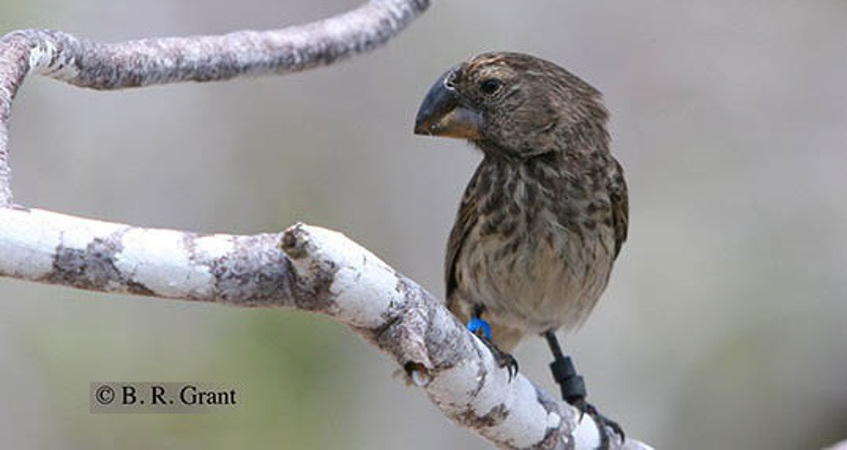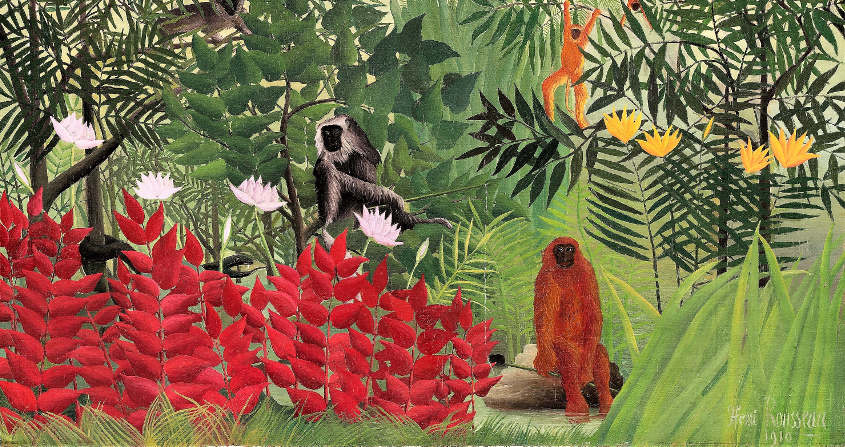进化论:误解与抵抗

以达尔文的工作为基础的现代进化理论,对我们认知世界是一场深刻的精神革命,至少有两个原因。一方面,它的一些概念,比如基因变异的随机性,尽管已被大量实验所证实,但却有悖于直觉,因此精神上很难接受。另一方面,它的唯物主义冒犯了我们几个世纪以来受宗教思想和人类中心主义塑造的思想,因此引起强烈的拒斥。即便在非信徒中,这种宗教思想常常以“自然母亲 “的神话和田园诗般的愿景中得到延伸,与现实截然相反。即使在自称是进化论者的科学作家或哲学家笔下,他们用来描述达尔文主义时所用的言辞也强烈表达了抵抗。
1. 简介
经过一个多世纪的研究,达尔文发现的生物进化的基本机制(参见达尔文)内容不断丰富,构成了现代进化论。然而,这仍然带来了严重的理解困难,引起不情愿接受、甚至拒绝接受进化论的观点。包括生物学家在内的科学家中也有这种态度。然而,在日常生活中,进化过程不断提及,特别是当涉及致病菌对抗生素、昆虫对杀虫剂或者植物对除草剂的耐药性时。但必须假定,许多人对这一过程的机制仍然不清楚,这一点已被社会学调查所证实。
2. 达尔文进化论
历时五年的环球旅行使查尔斯·达尔文反思物种起源,并对育种者的做法非常感兴趣。他观察到这些遗传变异是“自发且偶然”出现的,并不像拉马克之前所假设的是由环境引起的适应性变异(见下文)。但是,在一开始,达尔文并没有看到自然界中有什么可以发挥育种者选择的作用。马尔萨斯假设,相比于可获得的实物量,生物物种的繁殖尤为重要,1838年10月,达尔文读到这一观点时灵光一现。他在自传中写道:“通过长期观察动植物的习性,我已经充分理解各地的生存斗争,我立刻意识到,在这种情况下,有利的变异得以保存,不利的变异会被淘汰,其结果将是形成新的物种。现在,我终于有了一个理论…”[1]
因此,他在脑海中建立了理论的核心:“偶然遗传变异+自然选择”。变异作为进化的真正“引擎”,不断使种群适应其周围环境,直到最后物种改变。即使他了解其他因素,包括性别选择和隔离机制{指防止或严格限制同一地区的两个物种杂交的机制,即使物种间亲缘关系很近。还有一些机制阻碍物种交配或受精、或在受精后降低受精卵或由受精卵产生的杂交个体的活力或繁殖力。 } (见遗传多态性和选择)。
至于这些遗传变异的来源,对达尔文来说是个谜。那时,还没有科学知识可以回答这些问题。只有诞生遗传学和发现突变后,这个谜团才得以解开(参见遗传多态性和变异)。到了20世纪中叶,才有可能发展出“综合进化论”或“新达尔文主义”。
此后,大量研究证实了这一理论。最近,彼得和罗斯玛丽·格兰特研究了达尔文著名的加拉帕戈斯雀(图 1),证明了显示了两个主要内容:

«(a)在自然种群中,喙和体形等重要生态特征的遗传变异性很高;(b) 种群的特征变化速度很快,这些发现对于进化生物学家来说是一个很大的惊喜。» [2](见达尔文的雀)。
3. 达尔文主义与公众
IPSOS 2011年开展的调查表示[3],55%的法国人了解并接受进化论,9%是神创世论者,36%受访者 “没有明确的意见”。调查结果令人担忧,但我们可以放心地说,这总是比美国好,美国有40%的受访者是神创世论者,只有28%的人接受进化论。但事情没那么简单,在讨论或阅读过程中,我们很快意识到,接受进化论的人对其认知与科学相去甚远。社会学家多米尼克·吉洛(Dominique Guillo)最近的一项研究在很大程度上证实了这一点[4]。
对进化论本身的拒斥绝大多数是宗教原教旨主义者所为,我们不在此讨论。对于那些承认进化论事实的人来说,进化论的机制通常是他们误解甚至排斥的内容,两者之间的界限并不总是很明显。
3.1. 理解困难
人们往往对进化理论的两大支柱,偶然遗传变异和自然选择,知之甚少。

众所周知,狗不会生出猫。因此,根据常识,偶然的遗传变异如果导致重大变化,这完全违反直觉。然而,这对于家养物种来说是显而易见的,其中许多在自然界中会被自然选择淘汰的自发变异,因为饲养者得以保留和选择。植物中玉米的例子格外引人注目[5],我们每天看到的各种品种的犬科动物(图2)也是如此。在自然界中,正是这种特别的遗传可塑性使种类繁多的生物能够在千差万别的环境中生息繁衍。
自然选择也经常被误解。它通常被视为个体之间的斗争,是对弱者的残酷淘汰。这是一幅漫画。达尔文写道,斗争不一定是生物之间的斗争,它是使生命得以维持的一系列永久行为,包含进食、保护、繁殖。达尔文举例说,沙漠边缘植物努力生存,对任何个体都没有伤害。许多进化论著作将用“适者生存” 取代“自然选择”为,这意味着个体之间存在一种致命的竞争,这加剧了人们的误解。然而,达尔文直到第五版《物种起源》才使用了这一表达,因为他被错误地指责将自然选择拟人化人格化。实际上,这句话出自是赫伯特·斯宾塞(Herbert Spencer) ,当时他是公认的伟大哲学家,也是“社会达尔文主义”的真正倡导者[6],但他与达尔文的观点截然相反。
事实上,自然选择在本质上影响着繁殖成功。能够留下最多后代、能够活到生育年龄的基因变体,才会决定种群的未来。
3.2.理论接受困难
这第二种反应超出了理性范围。达尔文主义有时是一种真正的心理障碍的对象,与我们的文化紧密相关。正如纪尧姆·莱科因特(Guillaume Lecointre)所写的那样:“进化总是与我们的第一反应和深层反应背道而驰。为什么会这样?很简单,因为谈论进化就是谈论科学,而且只谈论科学”[7]。是的,但是这个话题非常敏感,因为它影响了我们对世界的整体认知以及我们在世界中所处位置。一些激进的反对者,甚至那些自称是进化论者,都会毫不犹豫地称达尔文主义为致命的理论”、“毁灭性唯物主义”、“被诅咒的传说”。我们显然处在一个激情澎湃的阶段。
这方面在这里只能非常简单地说明。更多细节,请参阅参考资料[8],特别是杰拉尔德·布朗纳(Gerald Bronner)的分析[9]和西里尔·鲍因(Cyrille Baudouin)与奥利维尔·布罗索(Olivier Brosseau)的调查[10]。
简而言之,接受达尔文主义的绊脚石在于该理论的唯物主义,以及把偶然事件视为理论的一部分。进化机制的两大支柱,遗传变异和自然选择,是两种物质的和盲目的力量,结果不可预测。我们不是必然进步的结果,而是一个非常偶然过程的结果。如果进化重新开始,我们没有理由相信会再次出现与我们相近的物种。这不仅冒犯了我们的人类中心主义{认为人是宇宙中最重要的中心实体、且通过唯一的人类视角来认识现实的哲学概念。亚里士多德最早提出这一理论,与地心说同时提出。 } ,但也是一种准宗教式的自然观,在环保运动中广为流传(参见盖亚假说[11])。

因此,在法国,大多数生物学家晚了半个世纪才接受进化论的观点,而当时流行的主要是拉马克主义,直到大约上世纪中叶。让·巴蒂斯特·拉马克(Jean-Baptiste Lamarck)是法国一位非常伟大的博物学家,他第一个提出关于生物物种进化的连贯理论(“进化理论”)。但就进化机制而言,拉马克假设环境影响占主导作用,并产生直接影响(图 3)。在他看来,至少对动物而言,“环境”、“需求”、“努力”改变了生物体,使其更加适应环境,而这些改变又传给了后代。这显然更符合社会道德:我们在努力中进步,并将这种进步传递给我们的孩子,这很棒!只是这一观点与一个多世纪以来获得的所有科学知识相矛盾(阅读拉马克和达尔文:对生活世界的两种不同看法)。
参考文献和注释
[1] Charles Darwin, Autobiography; Ed. Belin, 1985.
[2] http://www.balzan.org/fr/laureats/peter-e-rosemary-grant
[3] https://fr.wikipedia.org/wiki/Cr%C3%A9ationism
[4] Dominique Guillo, Ni Dieu, ni Darwin – Les Français et la théorie de l’évolution; Ed. Ellipses, 2009
[5] http://tp-svt.pagesperso-orange.fr/mais.htm
[6] http://www.lespiedsdansleplat.me/lheritage-de-darwin-et-ses-devoiements-le-grand-retour-du-darwinisme-social-2/
[7] Guillaume Lecointre (under the direction of), Guide critique de l’évolution : p.7; Ed. Belin, 2009.
[8] http://www.lespiedsdansleplat.me/les-multiples-chemins-de-lantiscience/
[9] http://www.cairn.info/revue-francaise-de-sociologie-2007-3-page-587.htm
[10] Cyrille Baudouin & Olivier Brosseau, Enquête sur les créationnismes, Ed. Belin, 2013; http://www.lespiedsdansleplat.me/la-montee-en-puissance-des-ideologies-creationnistes/
[11] James Lovelock – The Earth is a Living Being – The Gaïa Hypothesis, Champs Sciences, 1979.
环境百科全书由环境和能源百科全书协会出版 (www.a3e.fr),该协会与格勒诺布尔阿尔卑斯大学和格勒诺布尔INP有合同关系,并由法国科学院赞助。
引用这篇文章: BREGLIANO Jean-Claude (2024年3月14日), 进化论:误解与抵抗, 环境百科全书,咨询于 2025年1月21日 [在线ISSN 2555-0950]网址: https://www.encyclopedie-environnement.org/zh/vivant-zh/theory-of-evolution-misunderstandings-and-resistance/.
环境百科全书中的文章是根据知识共享BY-NC-SA许可条款提供的,该许可授权复制的条件是:引用来源,不作商业使用,共享相同的初始条件,并且在每次重复使用或分发时复制知识共享BY-NC-SA许可声明。









